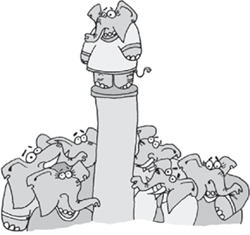CHAPTER SIX
Lonely @ the Top
Everybody likes a compliment.
—Abe Lincoln
You make me so lonely baby
I get so lonely
I get so lonely I could die.
(So I didn’t write this one. Elvis, “Heartbreak Hotel”)
![]() Why managing is lonely
Why managing is lonely
![]() Replace loneliness with peace, love, and understanding (thanks, other Elvis)
Replace loneliness with peace, love, and understanding (thanks, other Elvis)
Who wants to spend the day ordering people around… other than a bored older sister? Endless to do lists combined with a constant blast of pressures (not to mention those omnipresent meetings) can cause even a seasoned boss to snap. Yet you can learn how to balance pressures while simultaneously motivating others to excel.
It turns out that simple workplace friendships with direct reports aren’t so simple after all. You went from being one of the gang to being one of one. Sure, you understand things are different when you’re In Charge. You’re still the same friendly, supportive person, though. Why are you on the outside?
How does it happen?
Back to the Beginning
A promotion opportunity presents itself—what you’ve been visualizing into fruition for three long years. You furtively hope they hire from within, not some no-name, no-good hotshot who knows nothing about your industry. You and several of your peers apply. Jackpot! A wise executive management team selects you. You dedicate a glorious Sunday to moving your files and tchotchkes out of your cube and into an office with a real door.
You decide, in a flash of brilliance, to welcome in the new era under your reign by greeting everyone on Monday morning with a sponsored-by-you bagel breakfast.
You arrive an hour early, humming to yourself, and set up the lunchroom with all the best finishing touches. You make a little sign imploring your newly acquired staff to Help Yourself!, courtesy of you. You tastefully retreat to your office so as not to hover, and await a flood of gratitude.
Manners are a thing of the past, you declare silently to yourself by 11 a.m. You punch the keyboard with more gusto than is strictly necessary to send off a flurry of e-mails explaining the new systems you’ve been dying to put in place. Not one person has thanked you for the bagel breakfast you provided, let alone congratulated you on your new title and digs.
What is up with that?
Everything changes now. Your cronies are now your employees, and the two don’t mesh. You’re reminded of when your mom helpfully noted, “I’m not your friend! I’m your mother!” As if there was any confusion about the matter.
I’ve got stinky news. Please sit down. Ta-ta to work relationships as you knew them. Now you’re their boss, not their bud.
To be clear, all the others who vied for your position believe they deserved it more than you. They’re mad. Plus, they will search for evidence to confirm their theories by waiting for you to mess something up, and it won’t take long (I don’t mind being the person to tell you). They knew you weren’t qualified.
Which brings us to cognitive dissonance.
We just have be right, don’t we? We do. In fact, there’s an incredibly strong drive to be right. When we have a belief in the world and evidence disproves this belief, our brains go into overdrive to dispute that data. Sometimes we don’t even process the evidence. Cognitive dissonance can cause people to negate information that contradicts preexisting belief systems.
Let’s put together the pieces. The others who competed for your job believed they deserved it. This can easily lead to the idea that you intervened between them and their rightful promotion. So, at least initially, it’ll be difficult for them to accept you as qualified for the position. You’ll have to work to win them over. Not impossible, just lots of time, patience, and rapport building.
Also, sooner or later you’re going to have to give everyone else who works for you performance feedback. That’s generally no walk in the park. Particularly if an inadequate system precedes you and folks are used to coasting through, you have your work cut out for you. It’s best to work on positive relationships early on in your tenure… while maintaining your authority, of course.
What if you have one really, really good friend at work—actually you consider him your best friend—and you’re certain this relationship, at least, will remain intact through the storm of your promotion.
Perhaps you’re right. For every rule, there is an exception. Still, not to be Ms. Doom ’n’ Gloom, but this creates a whole new set of problems. You will—just expect it!—be accused of favoritism. You’re both on the hot seat. People won’t say this to your face. They will instead confirm each other’s suspicions, with increasing agitation among the troops.
Every Step You Take
The higher you rise, the more you are analyzed, discussed, and observed.
For a select few, that’s exciting. For most, it’s a tough pill to swallow. Your every move in the presence of others is watched and interpreted. Did you ever realize how riveting you are?! Don’t let it go to your head. A Thinker vice president of marketing with a creative edge and impatience for buy-in admitted, “I have gotten negative backlash—more than once, I’m sorry to say—when not aware enough of the impact of what I say or how I am saying it. Then I have to do damage control, which does not always work.”
I don’t envy the supremely famous. I figure that kind of life differs from imprisonment only in the backdrop. Imagine not being able to go to the park, playground, grocery shop, or neighborhood bistro without being scrutinized, photographed, and written up. Privacy vanishes as fast as a Top 20 pop song in the twenty-first century.
Assuming a leadership role within most professions invites nowhere near the level of scrutiny gracing superstars in sports, music, movies, and royal families, yet it certainly has a foothold on the continuum of being observed. Your selection of a venti triple-shot whip extra hot no foam skinny vanilla latte at the Starbucks in your company’s lobby is unlikely to land you a front-page photo in the tabloids. It’s just potential cause for a few of the masses behind you in the morning rush line to glance up from their iPhones, shooting you an irritated glare.
On the other hand, being in an influential position increases the ripple effect when you treat employees well, spearhead volunteer campaigns, and mentor new staff. The limelight brings potential for far-reaching impact as a positive role model.
Good with the bad, baby.
Let’s talk about the impact of coaching styles. Our everyone-gets-a-trophy society is pretty gung ho about what I call feel-good behaviors. A manager’s job is to make her staff feel good, right? Feel good about themselves, their tasks, and ultimately about her, too.
Imbalanced feel-good management backfires. A feel-good coach seeks opportunities to applaud efforts, believing this motivates people. Missing from the equation is a healthy mix of motivation and inspiration. A feel-good manager offers praise even for mediocre results.
Do Good or Feel Good?

My leadership programs frequently include activities that at first seem impossible to the participants. Teams are presented with a group challenge and are instructed to alert me when they believe they have done the best job possible given the resources they have.
More often than not, teams beckon me over quickly, asserting they have completed the task—at well below the level I know they can achieve. I do not accept their outcome and tell them I am certain they can do better. I remind them I am very busy and not to bother me again until results improve by 200 percent. Then I flounce away (the flounce is my favorite part).
Every team of the hundreds I have worked with exceeds its own expectations. Their enthusiasm is amusing, concluding with high fives, group photo ops, and embarrassing little dances.
What happened to dramatically improving outcomes… while also boosting morale?
In reality, inspiring people to do good prevails over the goal of making them merely feel good. Here’s the clincher: Do-good leadership makes teams feel better than feel-good leadership.
The natural inclination of many feelers can initially sway them to be feel-good coaches. However, coaxing people to do better, to exceed their own expectations rather than halting at early efforts, ultimately makes both the coach and the team feel better. Excelling is a natural high. Plus the coach garners respect and admiration.
As a manager in a marketing company shared, “My boss is ultra-demanding, and though our styles are very different, she has influenced me to expect—and get—more from my employees as well.”
When people do lackluster, run-of-the-mill work, they feel mediocre. In such cases, praise doesn’t boost their sense of accomplishment; it merely diminishes the value of praise. They recognize that their manager has a low bar, so they do too. They feel average about the work product as well.
Coach Ticket

Take a pen and a moment. Close your eyes… while remaining conscious. Recall a favorite coach from any time in your life. This can be a sports coach, supervisor, family member, teacher, mentor, friend—you get the general idea. The first person to enter your mind is generally the ticket.
My favorite coach: ___________________________
Now create a list of adjectives that describe this person: _________________
____________________ ___________________ _________________
____________________ ___________________ _________________
____________________ ___________________ _________________
____________________ ___________________ _________________
Reflect on your list. Was this a person a feel-good coach, a cheerleader? Or did this person push you further than you could have gone on your own—a do-good coach? In most cases, our best coaches are examples of tough love. We understand they are invested in us, believe in our potential, and are committed to our success. Their belief in us does not manifest in a sticky stream of superlatives. Rather, they razz and push and torment us to push, push, push through barriers. We strive hard to achieve their vision for our success.
To be an inspirational manager, demonstrate the characteristics you value, earn the respect of your team, and create a platform for them to jump higher than ever before.
When pushed and challenged, we rise to the expectations to which we are held.
This hoop-jumping exercise proves the point. If you skipped over it, skip on back. It only takes a few moments and makes it personal. Push on through to the other side.
Consensus Is So Old-School
Involving your team in decision-making can seem like a big ol’ Pandora’s box, propelling many managers to go it alone. Yet a well-designed process builds ownership and dissipates the burden of solo decision-making.
Structure and perceived fairness are key. This next tool provides both. Presto!
I am anticonsensus. Even though usual workplace convention holds consensus on a pedestal. We need to reach consensus! Consensus required! Everyone must work toward consensus.
In typical work cultures, consensus can be a major energy, time, and resource drain. How the heck is it supposed to be reached, anyway? In any group larger than, say, two, consensus is a pretty lofty ambition. People have varying viewpoints, opinions, personalities, and perspectives. To say we aren’t going to take action until we all agree is a bit nuts, yes? What happens when people don’t agree? We sequester them in a boardroom for a few weeks and hope for the best?
What people really want is a sense of fairness. A belief that they are taken seriously and their points of view are honored. That is not the same thing as always “winning.”
Enter multivoting. Multivoting has everything: simplicity, fairness, ease of use, flexibility, good looks.
Okay, maybe not that last one. Depends on the stickers used, I suppose. But I get ahead of myself.
Let’s say you are in a group (six to one hundred people) who must either prioritize among a set of choices or make a decision about a direction to take.
Display the options in large print around the room, on easel paper or whiteboards. Provide each participant with three small stickers. Anything will do—circles, stars, or go nuts and get artsy. I’m not so good at that stuff, myself.
Participants vote by putting the stickers under their selection(s). If a group member feels very strongly about a single, first choice, she will stick all three of her votes under the same option. If she has a first and second choice, she puts two stickers under number one and one under number two. If she has equal interest in three options, she can spread out all three stickers under different selections.
Rather than having group members just raise a hand for their first choice, multivoting enables them to demonstrate how strongly they feel about their choice… and to indicate what other option(s) they support to some degree.
Each time I use multivoting, a clear couple of winners emerge. The dots are concentrated in one to three top selections.
This technique is effective because no one feels dissed. It is a fair, open system. If I am only one of a few people voting for my top choice, I may feel disappointed, but I can’t argue the fairness of the decision.
People are relieved to arrive at a decision in a fraction of the time taken up by tedious consensus building.
There are variations on multivoting to suit virtually any situation. You can make the voting process anonymous by having participants place stickers (or other markers) in envelopes rather than openly displaying them on a poster or whiteboard. It can be conducted virtually, online. It can be accomplished outside, with no walls or stickers, by having participants raise one, two, or three fingers and assigning an unbiased counter. You get the concept.
Arrowheads

I have a deceptively simple activity in which I give teams of three to eight people a set of seven plastic geometric pieces, one in the shape of an arrowhead. Instructions are sparse: Create five simultaneously existing arrowheads of the same size and shape, using the pieces provided.
Piece of cake.
Some groups solve the challenge quickly, some take thirty minutes or more, some groups never solve the puzzle. Most groups realize it is easy to assemble four arrowheads and inform me there are not enough pieces for five. I carefully count the seven parts on their table and assure them that they have enough resources.
Have you ever worked with (or near) a team who made the same claim: “We don’t have enough resources to achieve our task”? And then another, comparable team somehow accomplishes the impossible with the same or fewer resources?
Sometimes in this activity a participant will short circuit. He will cling to the notion that the challenge is impossible. Even as other teams around him triumphantly announce success, he will continue to pronounce this an unsolvable task doomed to failure. Over and over, he will repeat his conviction.
From experience, I know his team will fail. They always do. One vocal naysayer will smash any hope of success to smithereens. The most common mistake I see in these situations is the manager letting the negative voice go on too loud and too long before addressing or mitigating the situation. Negative energy can jeopardize the outcome of an entire team.
When you ignore or downplay the significance of a single person’s negativity, the result spreads far beyond that individual. Speak to that person, look for the cause, discuss alternatives, ask for support. Don’t let a small flame turn into a wildfire that destroys everyone’s best efforts.
Parenthetically, the arrowhead puzzle requires thinking outside the box. Or, in this case, inside the arrowheads. Four arrowheads are created from the pieces provided and the fifth is created through the arrangement of the other four—in the negative space that appears when they are placed in the correct pattern. In case you were wondering.
Relationships: Bottom-Line Influence
Some executives believe results are what matter most, not relationships. Turns out, results and relationships are intertwined, even inseparable. First of all, there is quite a disconnect between how well leaders believe they are communicating with others and external reviews of their communication. A study found that 92 percent of managers rated themselves as doing an “excellent” or “good” job of managing employees, whereas only 67 percent of those reporting to the same managers agreed. Therefore, it is no surprise that managers dedicate an average of seven or more hours a week to sorting out personality conflicts.8
Time lost through conflicts and poor communication leads to lower employee retention and lost revenue. Investing time to establish clear communication channels eliminates a slew of headaches down the road.
 Flex!
Flex!
You’re in the spotlight, so make a conscious effort to be consistently friendly, open, and positive. At the same time, pushing people past their perceived limits is the management version of tough love and yields a stronger, more motivated team.
P.S. You have the resources you need to accomplish your goals.

